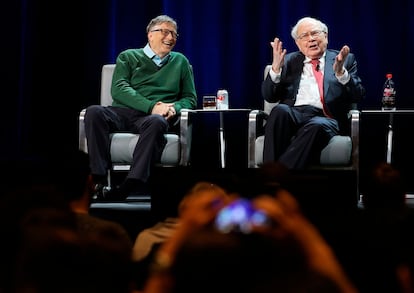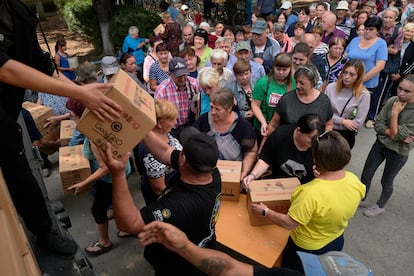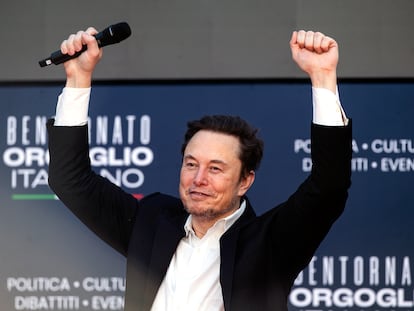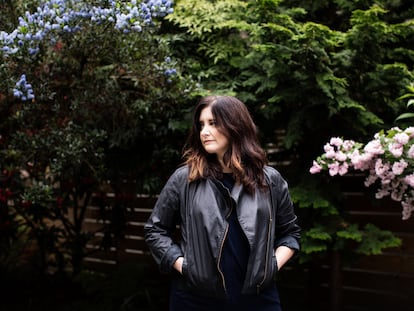A trickle of philanthropy: Why is generosity in crisis?
These days, donations are very volatile, with rich countries increasingly focused on financing domestic causes. They are turning their backs on the Global South


The world is currently in a donation crisis. Highly-publicized initiatives such as The Giving Pledge, undertaken by Bill and Melinda Gates, together with Warren Buffett, or specific outbursts of solidarity linked to events such as the pandemic or the war in Ukraine shouldn’t mask the fact that philanthropy is a very fickle thing. Contributions from individuals are very volatile and large multinationals find it difficult to make ends meet, while rich countries are allocating more money to local causes, often ones with religious, if not fundamentalist, overtones.
At the same time, a generational turning point is on the horizon, with the largest transfer of wealth in history between baby boomers and their children beginning to occur. Millennials and members of Generation Z have other priorities and sensitivities than their parents. Will they be able to build a world with greater solidarity?
The verb “give” is part of the essence of being human, because otherwise, the lives of hundreds of millions of people would be crushed. However, philanthropy traverses trenches of uncertainty, which further complicates the ability to address geopolitical instability. In Spain, for instance — an upper-income Western European democracy — the Association of Foundations calculates that charitable contributions from individuals make up barely 0.1% of GDP. Translated into cold numbers, this is less than $1.5 billion. “It’s a cultural problem. [Members of] society think that [there’s no need to donate] because they pay taxes,” laments the jurist Antonio Garrigues Walker. “Donating is, according to a conception that I consider erroneous, an obligation that always concerns the government, never the citizen.”
From a historical point of view, the governments of upper-income countries have never prioritized the virtue of generosity. And corporate philanthropy hasn’t avoided this crisis, either. “[There are] fewer tax havens and there’s less philanthropy,” explains Carlos Martín, a parliamentarian from the left-wing Sumar party in Spain. “We’re facing a contradiction of capitalism. In the past, with globalization, corporate outsourcing was [subsidized by governments] – they were even able to deduct the capital invested in [moving operations overseas]. And then, when they repatriated profits, the law exempted them from paying [the requisite taxes]... we have to rethink the model to make these firms contribute.”
In this wasteland, there are some bright spots. The La Caixa Foundation — one of the most generous in Europe — has an annual budget that exceeds $530 million. “Philanthropists tend to be dispersed, but with the right approach, [giving] can generate a change in the system,” says Mercedes Basso, the director of private banking philanthropy at CaixaBank. “The problem,” says Victoria López, an expert at International Financial Analysts (AFI), “is that we could understand the sector better if the watchdogs did their job well.” Some publish data, while others don’t.

Philanthropy deals with all the geopolitical uncertainties that surround us, along with some of its sector-specific problems. Giving money away is very difficult, especially for the 0.001% of the world’s ultra-rich population. Writing a check for millions of dollars to your alma mater, such as Yale University or Princeton, something that rich Americans have been doing for years, is no longer enough. Let’s consider MacKenzie Scott, the ex-wife of Jeff Bezos. She’s considered to be the most generous philanthropist in recent years. By the end of 2022, Scott had donated – without any strings attached – more than $14 billion to 1,600 organizations since her divorce from the Amazon founder back in 2019. She wants to give away at least half of her fortune. However, despite this effort, her assets haven’t stopped growing, due to the appreciation of the shares that she still holds in the distribution giant. When her marriage ended, her Amazon stock was worth around $36 billion. And now, according to Forbes, the good times on the stock market mean that the value has skyrocketed to $43.6 billion.
The magazine’s 2023 ranking includes 2,640 people who have a net worth of at least 10 figures. In total, they have about $12 trillion, or 2% of the entire planet’s wealth. By contrast, Bezos has only donated about 1% of his fortune.
“For many multi-billionaires, whether it’s [money they earned] or family money, donating brings up a tension that mixes anxiety and stress,” says Mark Reed, one of the heirs to the Reed family fortune. The Reeds are the fifth-largest landowner in the United States, according to The Observer, holding about 1.4 million acres.
A bleak landscape
The land of hopes and dreams also means surviving a barren landscape. Since the lonely hours of the pandemic, donations from billionaires to foreign causes have been declining. The United States is more generous when it comes to domestic causes. And the great donation destination is religion, well above the amount of humanitarian aid that reaches poor countries. While the U.S. Constitution guarantees the separation between church and state, one only has to analyze the ideology of the members of the Supreme Court to see that there’s hardly any real distance between the two. “Religion has an enormous influence on elections, especially due to the Evangelical vote,” reflects Mauro Guillén, vice dean of the Wharton Business School at the University of Pennsylvania. “In terms of philanthropy, the largest donations are religious, medical and educational. This poses a problem. The personal income tax deduction of contributions is very generous and unlimited, which means that the separation between church and state fails. There are those who ask that donations to religious entities not be tax-deductible, because [these organizations] have become a political force.”
There are many such contradictions in the U.S. Oil companies have historic profits and, at the same time, their non-profit entities allocate, according to Indiana University, between $7.8 and $9.2 billion each year to confront the climate emergency.
Corporate cronyism is also taking root in the U.K. The largest British companies, which are part of the FTSE 100 index, donated 1.85 billion pounds (or $2.4 billion) last year, according to the Charity Aid Foundation (CAF). This is considerably less than the amount that said firms donated a decade ago: 2.5 billion pounds, or $3.15 billion. A drop of 26%, which is even more dramatic when adjusted for inflation. “Organizations have a responsibility to contribute to philanthropy and do it well,” warns Margery Infield, director of social impact at the British think tank New Philanthropy Capital (NPC).
The invasion of Ukraine, however, served to shake this reality up. The Biden administration and the U.S. Congress have allocated more than $76.8 billion dollars in aid to the country to date, which includes humanitarian, financial and military support. This is the first time since the Marshall Plan that a European nation has been the principal recipient of U.S. funds.
In terms of humanitarian support alone, Ukraine has received $3.9 billion, along with $26.4 billion in financial aid. “There’s some donor fatigue, but a large majority of Americans still show concern for the country under attack,” observes Joseph Nye, a professor emeritus at Harvard Business School who served as secretary of defense under Bill Clinton.
The case of Ukraine
This aid supports a variety of things in Ukraine, from law enforcement to independent radio stations. If something positive can be said about an incalculable horror, it’s that the tendency of the United States and the United Kingdom to contribute less outside their borders in recent years has been reversed (at least temporarily). Only Sweden has increased humanitarian donations to overseas issues – 15% in 2021 to 27% in 2022 – with generosity. Back in 2020, the total international flows allocated to philanthropy stood at $70 billion, basically the same amount that Ukraine has absorbed on its own.

Traditionally, money flows have moved from rich northern countries to the Global South. This has changed, however, as lower-income countries wish to manage their own funds and decide their destinies: they don’t want humanitarian aid to be an excuse for “generous” neocolonialism. In line with this, according to data from the Citi Foundation, 80% of the new NGOs registered in Kenya were set up from within the country itself. An example: Education Sub Saharan Africa (ESSA), a charity firm founded in 2016, is a pioneer in “[identifying] scholarships and teaching students how to apply for them,” according to the Citi Foundation.
Nobody is waiting for funds from an unsupportive Global North. “There’s been a decrease in the volume of donations in real terms. We certainly don’t know why this has happened,” reveals Jonathan Roberts, director of teaching at the Marshall Institute at the London School of Economics (LSE). The teacher explains that this all started in 2016 and went down even further during the pandemic. It has never recovered. Confidence in charities has also been lost, something that’s a basic element for people to want to donate. The rising cost of living and job insecurity felt by young people may have created the perfect storm. “[Governmental support] has increased internationally, but this is due, in part, to the conflict in Ukraine,” he clarifies.
When China’s entry into the World Trade Organization (WTO) was facilitated in 2001, the signatory countries imagined a world of trade and a major country open to political liberalization, whose prosperity would alleviate misery. However, in terms of philanthropy, the idea that China’s ascension to the WTO would have a positive impact hasn’t panned out. “[Philanthropy] doesn’t exist in China,” opines Francesco Sisci, an Italian columnist who lives and works in Beijing. “People have to pay taxes even for donating to charities. And these institutions are managed by the state. No one wants to pay [the government] twice: once through charity and once through taxes.” Are these the values that guide the new great economic power on the planet?
“It’s a time to be bold, fight and take risks… [risks] that people on the ground cannot afford,” affirms Yamani Yansá Hernandez, CEO of the Groundswell Fund, an NGO based in San Francisco. “[Feminist philanthropy] is the redistribution of wealth, with confidence in the leadership and strategy of the most marginalized individuals, women and Black people.” This is something unimaginable in China, where the collective obscures the individual.
When you visit some of the most high-income liberal democracies in the world, you would think that the immense sums should be able to change philanthropy. The largest transfer of money across generations in the history of the planet is already underway. Between $84 and $100 trillion dollars — the figure varies, depending on the source — will go from the baby boomers (those born between 1955-1964) to the millennials (1981-1996) and members of Generation Z (1997-2012). About $12 trillion of this is expected to go to philanthropy. According to the Citi Foundation’s Global Economy v3.0 report, the criteria surrounding how funds are managed is going to change. There will be many more female investors and different priorities, such as the climate emergency, injustice and gender equality. If one wants to understand the magnitude of the transformation, American foundations distributed around $472 billion in scholarships in 2020 alone.
Still, the gaps are substantial. In 2019, American women and girls received, according to the Women’s Philanthropy Institute (WPI) at Indiana University, $7.9 billion in aid from non-profit organizations, about 1.9% of total donations. In 2017, African-American women and girls received only $395 million, less than half a percentage point of the total aid. At first, it’s assumed that this ongoing inequity is due to racism. But there’s much more to this story. A spokesperson from WPI explains how “[philanthropists] believe that certain areas, such as reproductive rights, are politicized. They have the idea that solving gender inequality is very complicated and that it cannot be separated from other problems in society.” The pandemic erased the progress made in terms of equality. Women and girls need additional funds to continue their path forward.
Most American philanthropists donate to whatever causes they choose, guided by their personal interests. This is one of the great changes of the new philanthropy, although it has also suffered unexpected damage in a time of hidden agendas. Sam Bankman-Fried, founder of the bankrupt cryptocurrency platform FTX, who has been accused of fraud, was a strong advocate of “effective altruism.” This philosophy is based on donating in terms of what is most cost-effective, a purely capitalistic criteria that contaminates philanthropy. Donors may want to resolve some of the world’s biggest problems, but find themselves engaged in the technology and financial sectors in increasingly murky ways. Hence, who is surprised when billionaires such as Barre Seid put forward an approach known as “attack philanthropy?” He donated all of his company’s shares (worth $1.6 billion) to the Marble Freedom Trust, placing none other than Leonard Leo, the architect of the conservative majority on the Supreme Court, as the head of the right-wing organization.
We’ve also seen the term “predatory inclusion” circulating as of late. For instance: an organization gives a marginalized community that has historically been excluded from the traditional banking system access to the use of virtual currencies. But there’s a predatory component to this: many people are able to make a profit at the expense of those who are kept in poverty, relying on the technology they offer.
The definition of philanthropy has also been dangerously expanded. Nowadays, donations can be made to public institutions and patronage can be practiced without actually contributing fresh money (as everything is written off). In Miami, Jorge Pérez, an art collector, philanthropist and billionaire, opines that “we’re at the tail end of philanthropy. And we’re fighting to change this situation and ensure that, at least, in the United States, Latinos become more involved in this activity.”
A very fragmented treasure map
“The rich are different from us,” Fitzgerald once commented, while sitting with Hemingway in Paris.
Hemingway responded ironically: “Yes, they have more money.”
In Western European countries, individual donations are dominant. In certain Southern European countries, such as Italy, there’s the phenomenon of banking foundations. Many of these entities, however, have declined significantly following the global financial crisis of 2008. Today, only the La Caixa Foundation, based in Spain, exceeds $500 million in donations annually, accounting for 20% of the country’s philanthropy. And then there are the companies that have their own foundations, implementing strategies of sponsorship and patronage. This is all part of the treasure map of generosity in the Global North.
“Those who exercise true philanthropy,” opines editor and curator Elena Foster, “do so out of total magnanimity, without expecting or seeking recognition.” She adds: “Philanthropy goes beyond kindness [and] the distribution of gifts. Philanthropy, in its deepest essence, is driven by empathy toward others, dedicating and donating to others what one has [earned] or has had the privilege of receiving.”
Everyone knows that birth is the true lottery of life. Everyone knows that there is a war between the rich and the poor, and everyone knows that the good guys are losing.
The momentum of Gates and Buffett
In August of 2010, 40 of the richest people in America pledged to donate the majority of their wealth to address some of society’s most pressing problems. Created by Warren Buffett, Melinda Gates and Bill Gates, The Giving Pledge platform came to life, following a series of conversations between philanthropists about how they could set a new standard for generosity among the ultra-wealthy. Although originally focused on the United States, the Giving Pledge sparked the interest of philanthropists around the world.
Currently, it has 241 members who are between the ages of 30 and 90, based in 29 countries. Their donations cover fields ranging from education to healthcare, renewable energy to housing. “The reaction of my family and me to our extraordinary good fortune is not guilt, but rather gratitude. Were we to use more than 1% of my claim checks on ourselves, neither our happiness nor our well-being would be enhanced. In contrast, that remaining 99% can have a huge effect on the health and welfare of others. That reality sets an obvious course for me and my family: keep all we can conceivably need and distribute the rest to society, for its needs. My pledge starts us down that course,” explained Warren Buffett, in his letter of support.
Sign up for our weekly newsletter to get more English-language news coverage from EL PAÍS USA Edition
Tu suscripción se está usando en otro dispositivo
¿Quieres añadir otro usuario a tu suscripción?
Si continúas leyendo en este dispositivo, no se podrá leer en el otro.
FlechaTu suscripción se está usando en otro dispositivo y solo puedes acceder a EL PAÍS desde un dispositivo a la vez.
Si quieres compartir tu cuenta, cambia tu suscripción a la modalidad Premium, así podrás añadir otro usuario. Cada uno accederá con su propia cuenta de email, lo que os permitirá personalizar vuestra experiencia en EL PAÍS.
¿Tienes una suscripción de empresa? Accede aquí para contratar más cuentas.
En el caso de no saber quién está usando tu cuenta, te recomendamos cambiar tu contraseña aquí.
Si decides continuar compartiendo tu cuenta, este mensaje se mostrará en tu dispositivo y en el de la otra persona que está usando tu cuenta de forma indefinida, afectando a tu experiencia de lectura. Puedes consultar aquí los términos y condiciones de la suscripción digital.
More information
Archived In
Últimas noticias
There is as much life left to discover on planet Earth as that which is already known
Dozens presumed dead, around 100 injured in fire at Swiss Alps bar during New Year’s celebration
Is porn for women different from conventional porn? We spoke to those who make it
Cartagena de Indias is sinking: What can the city do to mitigate it?
Most viewed
- Reinhard Genzel, Nobel laureate in physics: ‘One-minute videos will never give you the truth’
- David King, chemist: ‘There are scientists studying how to cool the planet; nobody should stop these experiments from happening’
- Oona Chaplin: ‘I told James Cameron that I was living in a treehouse and starting a permaculture project with a friend’
- Sinaloa Cartel war is taking its toll on Los Chapitos
- The Interoceanic Train, the Mexican alternative to the Panama Canal










































